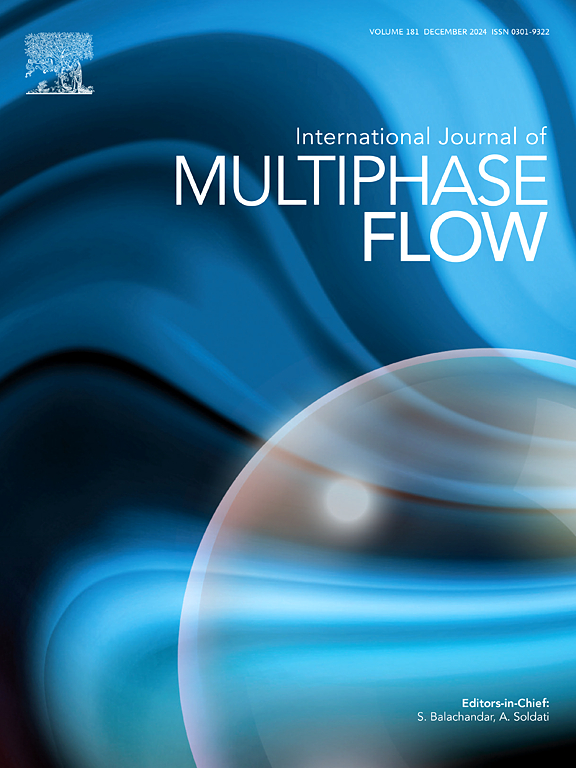多孔介质层状管道中的Hagen-Poiseuille流动是线性不稳定的
IF 3.6
2区 工程技术
Q1 MECHANICS
International Journal of Multiphase Flow
Pub Date : 2025-04-16
DOI:10.1016/j.ijmultiphaseflow.2025.105243
引用次数: 0
摘要
长期线性稳定的Hagen-Poiseuille流动在管道内表面出现低渗透多孔介质时变得不稳定。分析表明,随介质渗透率的不同,流体层厚度存在一个阈值,低于该阈值时,轴对称扰动会发生失稳,高于该阈值时,非轴对称扰动也会发生失稳。在前一种情况下,由于基流动力学与多孔层的相互作用而诱发失稳,并导致失稳的多孔模式。后一种情况是由于流体状态下的雷诺应力和界面处的滑动多孔边界的共同作用,导致流体模式的不稳定。例如,当Darcy数(Da)和beaver - joseph滑移系数(αBJ)分别为10−6和0.1时,厚度比的阈值t ̄约为0.0336。我们的结果表明,t -的阈值随着Da的增加而单调增加。在流体模式下,由雷诺应力产生的能量通过粘滞耗散损失来平衡,而在多孔模式下,主要通过表面阻力和界面做功的综合能量损失来平衡。此外,在保持多孔区厚度不变的情况下,具有几乎相似失稳特征的流体层厚度与介质渗透率的平方根成正比。严密的分析还表明,αBJ对流动具有一定的失稳作用,当雷诺数小于695,Da=10−6,αBJ=0.3, t =0.016时,不稳定开始发生。αBJ的增加导致流体层厚度相对较低的流体模式。本文章由计算机程序翻译,如有差异,请以英文原文为准。

Hagen–Poiseuille flow in the pipe layered by porous medium is linearly unstable
The long-standing linearly stable Hagen–Poiseuille flow is shown to become unstable when a low-permeable porous medium layers the inner surface of the pipe. The analysis indicates that depending upon the media permeability, a threshold value of the fluid layer thickness exists below which the onset of instability occurs under axisymmetric disturbances, whereas above the threshold value, the same occurs under non-axisymmetric disturbance. In the former case, the instability is induced due to the interaction of the dynamics of base flow with the porous layer and leads to the porous mode of instability. The latter case is due to the combined effect of Reynolds stress in the fluid regime and slip porous boundary at the interface, and gives rise to the fluid mode of instability. For instance, when the Darcy number () and Beavers-Joseph slip coefficient () are fixed at and 0.1, respectively, the threshold value of thickness ratio, is around 0.0336. Our results show that the threshold value of increases monotonically with an increase in . In the fluid mode, energy production due to Reynolds stress is balanced by energy loss via viscous dissipation, whereas in porous mode, the same is balanced mainly by combined energy loss via surface drag and work done at the interface. In addition, keeping the thickness of the porous region fixed, the fluid layer thickness for which almost similar instability characteristics are found varies directly as the square root of media permeability. Our rigorous analysis also shows that destabilizes the flow, and the onset of instability takes place at Reynolds number as small as 695, when and . Furthermore, an increase in invites the fluid mode for relatively low values of fluid layer thickness.
求助全文
通过发布文献求助,成功后即可免费获取论文全文。
去求助
来源期刊
CiteScore
7.30
自引率
10.50%
发文量
244
审稿时长
4 months
期刊介绍:
The International Journal of Multiphase Flow publishes analytical, numerical and experimental articles of lasting interest. The scope of the journal includes all aspects of mass, momentum and energy exchange phenomena among different phases such as occur in disperse flows, gas–liquid and liquid–liquid flows, flows in porous media, boiling, granular flows and others.
The journal publishes full papers, brief communications and conference announcements.

 求助内容:
求助内容: 应助结果提醒方式:
应助结果提醒方式:


